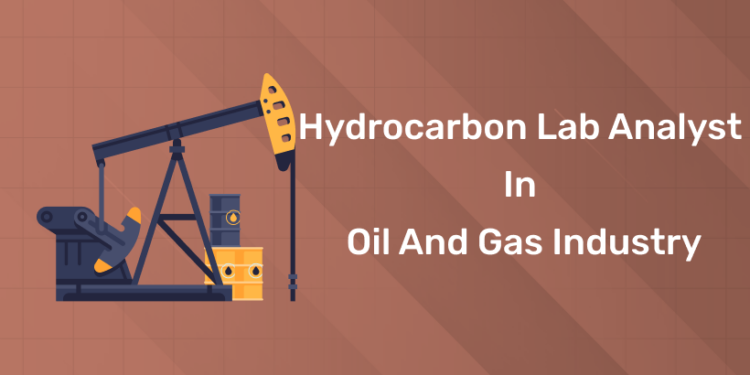Table of Contents
In this blog we will learn about the Hydrocarbon Lab Analyst in Oil and Gas Industry. A Hydrocarbon Lab Analyst plays a vital role in the oil industry.They analyze petroleum products to ensure quality and compliance standards. This includes testing for chemical composition, impurities, and physical properties. Accurate data helps in refining processes and product optimization. Analysts use advanced lab equipment to conduct precise measurements. Their work ensures safety and efficiency in oil and gas operations. Strong attention to detail and analytical skills are essential. They collaborate with engineers and other professionals for quality control. Continuous learning of new technologies enhances their expertise in the field.
Get Certified! Get Confident! Join our Oil and Gas Course!
Hydrocarbon Lab Analyst in Oil and Gas Industry
Key Responsibilities
1. Sample Testing
- Analyze crude oil and refined product samples.
- Test for chemical composition and impurities.
- Assess physical properties like viscosity and density.
2. Equipment Operation
- Use gas chromatographs and spectrometers.
- Calibrate lab instruments for accuracy.
- Troubleshoot equipment issues.
3. Data Documentation
- Record test results accurately.
- Report findings to relevant teams.
- Maintain organized lab records.
4. Quality Control
- Ensure products meet industry standards.
- Support engineers in refining processes.
- Verify compliance with environmental regulations.
5. Safety Compliance
- Follow safety protocols in the lab.
- Handle hazardous materials responsibly.
- Use protective gear as required.
6. Continuous Learning
- Stay updated on new testing methods.
- Learn about industry advancements.
- Adapt to emerging technologies.
Educational background and certifications required
Educational Background
- Degree in Chemistry or Related Field
- Chemistry, Chemical Engineering, or related degrees are preferred.
- Strong Foundation in Organic Chemistry
- Understanding of hydrocarbons and organic compounds is essential.
- Knowledge of Physical Sciences and Lab Techniques
- Skills in scientific analysis and lab methods are crucial.
Certifications You Can Take
- ISO Standards Certification
- Ensures compliance with international quality and safety standards.
- HSE (Health, Safety, and Environment) Certification
- Demonstrates safety knowledge in handling hazardous materials.
- Oil and Gas Course from Entri
- Entri offers specialized skills training in oil refining and hydrocarbon analysis.
- Laboratory Practices Certification
- Validates proficiency in conducting accurate lab tests and analyses.
Tools and Equipment
Hydrocarbon Lab Analysts use specialized tools to analyze hydrocarbons accurately. These tools ensure the quality and safety of oil and gas. By using the right equipment, analysts obtain precise results. The following sections provide an overview of essential lab tools.
1. Sample Collection Tools
Sample Containers
Special containers store hydrocarbon samples without contamination. They preserve the sample’s integrity during storage and transportation. Proper sealing prevents loss of volatile components. These containers are critical for accurate analysis results.
Sampling Probes and Dippers
Sampling probes collect liquid and gas samples from tanks or pipelines. These tools ensure the sample is representative and uncontaminated. Proper tools help obtain accurate and reliable test results.
Sampling Valves
Sampling valves extract samples from pressurized systems safely. They maintain the sample’s properties during collection. Regular maintenance keeps valves functioning correctly. This ensures reliable samples for accurate analysis.
2. Analytical Instruments
Gas Chromatograph (GC)
The GC separates and measures hydrocarbons in a sample. It identifies the concentration of different components accurately. The GC is essential for detecting impurities in samples.
Mass Spectrometer (MS)
The MS identifies and quantifies compounds by measuring ions. It provides detailed molecular information about the hydrocarbons. The MS is highly sensitive, detecting even trace substances.
High-Performance Liquid Chromatograph (HPLC)
HPLC separates and analyzes liquid hydrocarbons for complex mixtures. It is crucial for identifying heavier hydrocarbons. HPLC is valuable for ensuring liquid hydrocarbon quality.
Fourier Transform Infrared Spectrometer (FTIR)
FTIR analyzes hydrocarbon structures by measuring infrared light absorption. It identifies functional groups and assesses sample quality. FTIR provides rapid, non-destructive analysis for quality control.
3. Physical Property Testing Equipment
Viscometer
Viscometers measure hydrocarbon viscosity, indicating flow characteristics. Accurate viscosity measurements are crucial for understanding fluid behavior. Different viscometers are used based on the sample type.
Density Meter
Density meters measure the mass per unit volume of hydrocarbons. This helps assess the quality and grade of oils and fuels. Accurate density readings influence pricing and compliance.
Flash Point Tester
Flash point testers determine the lowest temperature hydrocarbons can ignite. Accurate flash point measurements are essential for safety and compliance. Regular calibration ensures tester accuracy.
Pour Point Tester
Pour point testers measure the lowest temperature hydrocarbons remain pourable. This property is important for assessing cold climate suitability. Accurate pour point testing ensures reliable product performance.
4. Safety and Environmental Monitoring Equipment
Gas Detectors
Gas detectors monitor harmful gases in the laboratory environment. They detect volatile compounds and hazardous gases. Regular calibration ensures detectors function correctly and reliably.
Fume Hoods
Fume hoods ventilate harmful fumes during experiments. They protect analysts from inhaling dangerous vapors. Proper use and maintenance ensure fume hoods work effectively.
Personal Protective Equipment (PPE)
PPE includes gloves, goggles, lab coats, and respirators. Wearing PPE prevents chemical exposure and accidents. Proper training ensures analysts use PPE correctly.
5. Data Analysis and Reporting Tools
Laboratory Information Management System (LIMS)
LIMS software manages data from sample collection to reporting. It automates processes and reduces the risk of errors. LIMS ensures efficient and accurate data management.
Statistical Software
Statistical software analyzes and interprets lab data. It identifies trends and ensures the reliability of test results. Statistical tools support decision-making and quality control.
Calibration Tools
Calibration tools maintain the accuracy of analytical instruments. Regular calibration ensures instruments provide reliable results. Proper use of calibration tools ensures consistent, accurate analysis.
Work Environment
The work environment of a Hydrocarbon Lab Analyst is specialized and controlled. It includes specific areas for different tasks and advanced safety features. Analysts must be familiar with sophisticated equipment and follow strict safety protocols. This environment ensures accurate analysis and protects analysts from potential hazards. Below is a detailed breakdown of key aspects of this work environment.
1. Laboratory Setting
Controlled Environment
Hydrocarbon labs maintain consistent temperature and humidity for accuracy. These controlled conditions prevent external factors from affecting samples. Precision is crucial in the lab environment to ensure reliable results. The environment is designed to support delicate and accurate measurements.
Specialized Equipment
The lab is equipped with advanced instruments like Gas Chromatographs. These devices require regular calibration and careful handling by analysts. Understanding and operating these tools correctly is essential. Proper maintenance ensures the equipment provides accurate results.
Safety Features
Safety features like fume hoods and gas detectors are vital. These systems protect analysts from exposure to harmful chemicals and gases. Emergency showers and eyewash stations are also available. Regular checks ensure all safety features function correctly.
2. Workstations and Layout
Designated Work Areas
The lab is divided into specific areas for different tasks. This division helps in organizing work efficiently and safely. Sample preparation, analysis, and data recording each have designated spaces. Clear separation of tasks minimizes contamination risks.
Ergonomic Considerations
Workstations are designed with ergonomics to reduce strain on analysts. Proper seating, adjustable benches, and good lighting improve comfort. Analysts spend long hours working, so ergonomic design is crucial. This design reduces fatigue and increases productivity.
Storage and Organization
Storage areas are well-organized to keep chemicals, samples, and tools safe. Proper labeling and systematic storage prevent cross-contamination. Organized storage ensures easy access to necessary materials and equipment. This organization contributes to a clean and efficient work environment.
3. Safety and Health Protocols
Personal Protective Equipment (PPE)
Analysts are required to wear PPE like lab coats, gloves, and goggles. PPE is essential for protecting against chemical spills and other hazards. Regular training on the correct use of PPE is mandatory. Proper use of PPE reduces the risk of accidents.
Hazardous Material Handling
Strict protocols are in place for handling hydrocarbons and chemicals. Analysts are trained in safe handling practices and emergency procedures. Proper disposal of hazardous waste is crucial to prevent contamination. Following these protocols ensures a safe work environment.
Regular Safety Drills
Safety drills, like fire and chemical spill drills, are conducted regularly. These drills prepare analysts for emergency situations. Regular practice reinforces the importance of safety protocols. Drills ensure that everyone knows how to respond in case of an emergency.
4. Work Hours and Schedules
Standard Hours
Most Hydrocarbon Lab Analysts work standard business hours. However, some labs operate continuously, requiring flexibility in scheduling. Analysts must adapt to different work schedules based on lab needs. Flexibility is key to managing various work demands.
Shift Work
In 24/7 labs, analysts may be required to work in shifts. Shift work can include night or weekend hours. This schedule ensures that analysis and testing continue without interruption. Shift work requires adaptability and good time management.
Overtime and Deadlines
Analysts may need to work overtime during peak periods or urgent projects. Meeting deadlines is critical, especially for time-sensitive analyses. Overtime work is usually compensated, but requires careful time management. Proper planning helps in managing workloads efficiently.
5. Collaboration and Communication
Team Environment
Hydrocarbon Lab Analysts often work as part of a team. Collaboration is essential for sharing data and solving complex problems. Team meetings help in discussing progress and addressing challenges. Working together ensures accurate and consistent results.
Interdisciplinary Collaboration
Analysts may collaborate with engineers, chemists, and other specialists. Interdisciplinary work ensures that all aspects of analysis are covered. Effective communication with other departments is crucial for success. Collaboration leads to well-rounded and thorough analyses.
Reporting and Documentation
Accurate documentation of procedures and results is a key part of the job. Analysts must maintain detailed records and reports for each analysis. Proper documentation ensures transparency and traceability. These records are often reviewed by supervisors and other stakeholders.
Career Path and Opportunities
A career as a Hydrocarbon Lab Analyst offers growth opportunities. Analysts start with entry-level roles and advance through experience. Below is a simplified overview of the typical career path.
1. Entry-Level Positions
Lab Technician
Lab Technicians handle basic sample preparation and routine tests. They gain hands-on experience and learn lab protocols. This role builds essential skills for future advancement. Technicians often assist with equipment maintenance as well.
Junior Lab Analyst
Junior Lab Analysts conduct more complex tests and analyses. They work with advanced instruments like Gas Chromatographs. This role involves interpreting data with supervision. Junior Analysts continue to develop their technical skills.
2. Mid-Level Positions
Senior Lab Analyst
Senior Lab Analysts lead projects and manage lab teams. They perform complex analyses and ensure data accuracy. This role includes mentoring junior staff. Senior Analysts play a key role in lab operations.
Quality Control Specialist
Quality Control Specialists ensure lab results are consistent and accurate. They implement and monitor quality assurance protocols. This role is vital for maintaining high standards. QC Specialists focus on preventing errors.
Environmental Analyst
Environmental Analysts examine hydrocarbons in environmental samples. They assess the impact on ecosystems and ensure regulatory compliance. This role involves working closely with environmental teams. Environmental Analysts contribute to sustainable practices.
3. Advanced Positions
Lab Manager
Lab Managers oversee all lab operations, including staff and equipment. They handle budgeting, scheduling, and quality control. This role requires strong leadership and organizational skills. Lab Managers ensure the lab runs smoothly.
Research and Development (R&D) Scientist
R&D Scientists develop new testing methods and improve existing ones. They conduct research and collaborate with other specialists. This role focuses on innovation in hydrocarbon analysis. R&D Scientists drive technological advancements.
Consultant
Consultants provide expertise on lab practices and quality control. They may help set up new labs or improve operations. This role offers flexibility and diverse client interactions. Consultants often work independently.
4. Specialized Roles
Forensic Analyst
Forensic Analysts investigate hydrocarbon-related incidents like spills or leaks. They analyze samples to determine causes and impacts. This role requires a deep understanding of hydrocarbons. Forensic Analysts often work with legal teams.
Regulatory Compliance Officer
Compliance Officers ensure labs follow industry regulations. They conduct audits and review procedures to prevent legal issues. This role is crucial for maintaining regulatory compliance. Compliance Officers stay updated on laws and guidelines.
Educator or Trainer
Educators and Trainers share their knowledge with students or staff. They teach at universities or provide in-house training. This role is ideal for those who enjoy mentoring. Educators and Trainers shape the next generation of analysts.
Get Certified! Get Confident! Join our Oil and Gas Course!
Common Challenges Faced in the Role
Hydrocarbon Lab Analysts face several challenges in their roles. These issues affect their work and results. Below are some common challenges in this profession.
1. Sample Contamination
Handling Samples Carefully
Contaminated samples can lead to inaccurate results. Analysts must handle samples with care. Proper storage and processing prevent contamination. Contamination can lead to costly re-testing and delays.
Preventing Cross-Contamination
Preventing cross-contamination between samples is essential. Use clean equipment and follow protocols. Effective labeling reduces contamination risks. Adhering to best practices ensures reliable results.
2. Equipment Maintenance
Regular Calibration
Equipment must be calibrated regularly for accuracy. Miscalibrated instruments produce misleading data. Analysts must maintain and calibrate their tools. Regular maintenance is necessary for reliable equipment.
Handling Equipment Failures
Equipment failures can disrupt lab operations. Analysts need to troubleshoot or report issues. Quick resolution minimizes downtime and keeps productivity high. Knowing common problems helps in managing failures.
3. Data Accuracy
Ensuring Precision
Accurate data is crucial for reliable analysis. Analysts must ensure precise measurements and calculations. Small errors can affect results significantly. Quality control measures help maintain accuracy.
Interpreting Complex Data
Interpreting complex data from mixed samples is challenging. Analysts need skills to identify and quantify components. Advanced analytical skills are necessary for accurate interpretation. Training helps improve data analysis skills.
4. Safety and Compliance
Adhering to Safety Protocols
Lab safety involves hazardous chemicals and equipment. Analysts must follow safety protocols strictly. Using PPE and safety equipment is essential. Regular safety training ensures compliance with regulations.
Meeting Regulatory Standards
Labs must comply with industry regulations and standards. Keeping up with changing regulations is challenging. Analysts need to adjust procedures accordingly. Compliance prevents legal issues and maintains lab credibility.
5. Time Management
Managing Workload
Analysts handle multiple tasks and tight deadlines. Effective time management is crucial for meeting deadlines. Prioritizing tasks and organizing workflows helps manage workload. Good time management is essential during busy periods.
Handling Unexpected Issues
Unexpected issues, like equipment failures, can arise. Analysts must address these while managing regular tasks. Flexibility and problem-solving skills are necessary. Efficiently managing issues ensures smooth operations.
Hydrocarbon Lab Analyst in Oil and Gas Industry: Conclusion
1: What is the primary purpose of a refinery in the oil and gas industry?
Hydrocarbon Lab Analysts play a crucial role in the oil and gas industry. They ensure accurate analysis of hydrocarbon samples and maintain data integrity. Their work supports safety, quality, and compliance with regulations. Analysts must handle complex instruments and follow strict safety protocols. They face challenges such as sample contamination and equipment maintenance. Effective time management and problem-solving are key to success. Continued learning and adaptation are essential in this evolving field. Overall, their expertise ensures reliable results and operational efficiency.
Watch the following video for more information on Hydrocarbon lab analyst in Oil and Gas Industry.
Frequently Asked Questions
What does a Hydrocarbon Lab Analyst do?
- Analyze hydrocarbon samples for composition and quality.
- Operate advanced analytical instruments like Gas Chromatographs.
- Perform tests to ensure compliance with industry standards.
- Interpret data and generate reports on findings.
- Maintain and calibrate lab equipment.
What qualifications are needed to become a Hydrocarbon Lab Analyst?
- Bachelor’s degree in Chemistry, Chemical Engineering, or a related field.
- Experience in a lab environment is often required.
- Knowledge of analytical techniques and equipment.
- Certifications or additional training in hydrocarbon analysis are beneficial.
What types of equipment do Hydrocarbon Lab Analysts use?
- Gas Chromatographs (GC) for separating and measuring hydrocarbons.
- Mass Spectrometers (MS) for detailed molecular data.
- High-Performance Liquid Chromatographs (HPLC) for complex mixtures.
- Fourier Transform Infrared Spectrometers (FTIR) for molecular structure analysis.
What are common challenges faced by Hydrocarbon Lab Analysts?
- Sample contamination affecting data accuracy.
- Equipment maintenance and calibration issues.
- Ensuring precision in complex data interpretation.
- Adhering to safety protocols and regulatory compliance.
How important is safety in the role of a Hydrocarbon Lab Analyst?
- Safety is critical due to handling hazardous chemicals.
- Personal Protective Equipment (PPE) is mandatory.
- Strict adherence to safety protocols is essential.
- Regular safety training and drills are required.
What career advancement opportunities exist for Hydrocarbon Lab Analysts?
- Progress to roles such as Senior Lab Analyst or Lab Manager.
- Specialize in fields like Quality Control or Environmental Analysis.
- Move into Research and Development (R&D) positions.
- Consider consulting or educational roles in the industry.
How do Hydrocarbon Lab Analysts contribute to the oil and gas industry?
- Ensure the quality and safety of hydrocarbon products.
- Provide accurate data for operational and regulatory decisions.
- Support environmental compliance by analyzing samples.
- Help optimize processes and improve product quality.












